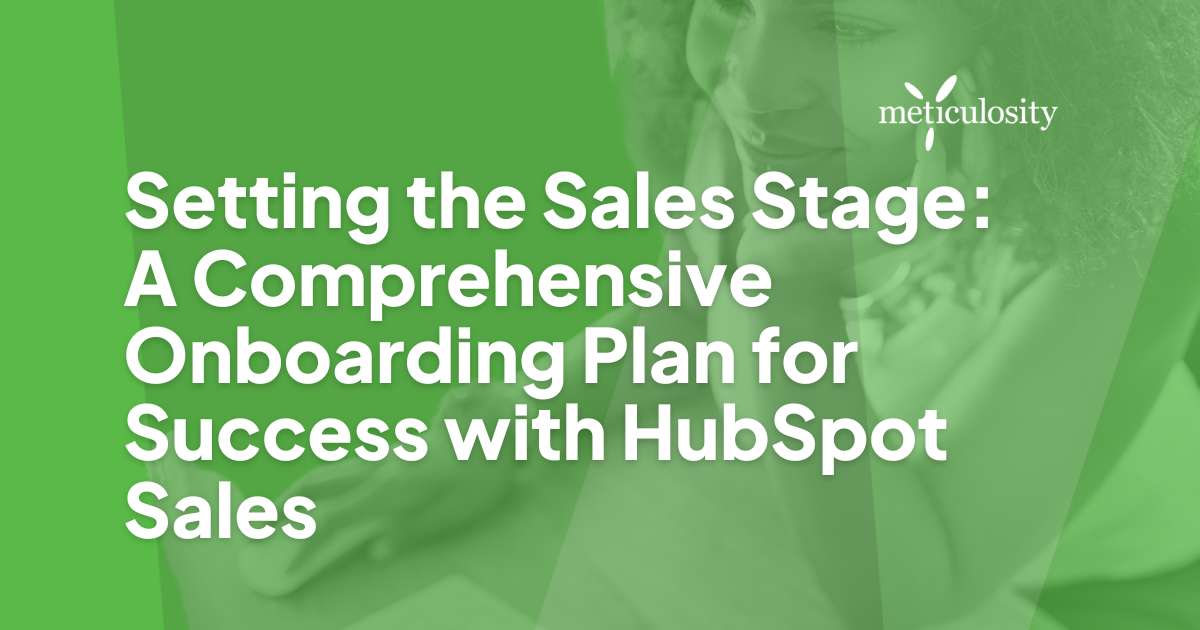Embarking on a sales career can seem like setting sail in vast, unknown seas—with tools like HubSpot Sales acting as both compass and map.
Through dedicated research and hands-on trials, we've pieced together an onboarding guide designed to demystify the intricacies of HubSpot Sales.
Key Takeaways
- Effective sales onboarding with HubSpot Sales is essential for setting up new team members for success from day one, ensuring they can navigate the software efficiently and utilize its CRM for maximum impact on the sales process.
- Understanding the inbound sales methodology, identifying and qualifying leads effectively, developing tailored sales pitches, providing role-specific training, setting clear performance expectations, and offering ongoing support are vital components of a comprehensive onboarding plan.
- Tailoring training materials to meet the needs of different sales roles, conducting scenario-based practice sessions, providing specialized coaching and job shadowing opportunities, and regularly assessing individual progress contribute to equipping every sales team member with the necessary skills and knowledge.
The Importance of Effective Sales Onboarding
Effective sales onboarding sets up new team members for success from day one. It's like giving them a map and a compass in the sales world. They need to know how to talk to customers, handle the sales tools, and understand what we expect from them.
They might feel lost or confused without good onboarding, leading to mistakes and missed opportunities.
Make sure every person who joins our team goes through thorough training. This includes learning about HubSpot Sales, our products, and how to connect with buyers. A solid start means they can get going quickly and bring in great results for our company.
It’s all about helping them be confident to do an awesome job selling our services or products immediately.
Looking to optimize HubSpot for your business? Learn how to improve here.
Sales Process and Buyer's Journey
Understanding the inbound sales methodology is crucial for success. Identifying and qualifying leads and developing effective sales pitches are essential steps in converting prospects into customers.
Understanding the inbound sales methodology
The inbound sales methodology focuses on attracting potential customers by creating valuable content and experiences tailored to their needs. It involves understanding the buyer's journey, identifying qualified leads, and engaging them with personalized solutions.
By aligning sales strategies with the customer's interests and challenges, businesses can build trust and credibility, ultimately leading to more successful conversions.
Inbound sales also emphasize the importance of leveraging technology to provide relevant information at each stage of the buyer's journey. This approach aims to empower prospects with valuable insights rather than aggressive selling tactics.
Identifying and qualifying leads
Identifying and qualifying leads is crucial for sales success. Here are key steps to do this effectively:
- Conduct thorough market research to understand the target audience and their needs.
- Use HubSpot's tools to track website visitors and identify potential leads.
- Implement lead scoring to prioritize leads based on their engagement and fit with your ideal customer profile.
- Utilize forms and landing pages to capture lead information and qualify their interest.
- Segment leads based on demographics, behavior, and interaction with your content.
- Qualify leads by assessing their budget, authority, need, and timeline (BANT) to determine their readiness for a purchase.
Developing effective sales pitches
When developing effective sales pitches, focus on understanding the buyer's needs and pain points. Emphasize the unique value proposition of our product or service and tailor the pitch accordingly.
By using compelling storytelling and addressing objections proactively, aim to create a persuasive narrative that resonates with potential clients. Additionally, leverage data and insights from HubSpot to personalize your approach, ensuring that each pitch speaks directly to the individual customer's challenges and goals.
Incorporating mentor feedback and analyzing successful pitches can help you continually refine your approach. Through ongoing training, resources, and self-learning, strive to enhance your sales techniques by staying updated with industry trends while adapting your strategy based on performance metrics and KPIs.
Role-Specific Training and Expectations
Provide training for different sales roles and set clear performance expectations. You will also need to discuss the various roles within the sales team to ensure everyone understands their responsibilities.
Training for different sales roles
Training for different sales roles is crucial to ensure that each sales team member is equipped with the skills and knowledge they need. Here's how to tailor training to meet the needs of different sales roles:
- Customized material: We provide role-specific training materials, focusing on the unique responsibilities and challenges associated with each role, such as inside sales, account executives, or sales development representatives.
- Hands-on practice: Each role undergoes scenario-based training to simulate real-world situations they may encounter. This allows them to practice handling various aspects of their job in a safe environment.
- Specialized coaching: Our trainers are experts in their specific areas and offer personalized coaching sessions tailored to the needs of each sales role, ensuring that individuals receive targeted support.
- Job shadowing: New hires can shadow experienced team members in their respective roles, giving them firsthand insight into their job and allowing them to observe best practices in action.
- Role-specific workshops: We conduct workshops focused on honing role-specific skills, such as negotiation techniques for account executives or effective prospecting strategies for inside sales representatives.
- Assessment and feedback: Regular assessments are conducted to gauge individual progress, followed by constructive feedback sessions designed to help each salesperson grow in their particular role.
- Continuous learning pathways: After initial onboarding, we provide ongoing learning opportunities tailored to each role's professional development needs, keeping skills sharp and knowledge up-to-date.
Setting expectations for performance
Setting clear expectations for performance is crucial in ensuring that everyone on the sales team understands what is expected of them. This involves clearly defining key performance indicators (KPIs), such as sales targets, activity metrics, and customer satisfaction goals.
Outlining these expectations from the beginning provides a roadmap for new hires to understand what success looks like in their role. It also creates accountability and gives them a clear understanding of how their contributions impact team success.
It's important to communicate these expectations transparently and regularly revisit and discuss them with each sales team member. This helps align individual goals with broader company objectives, foster a sense of ownership, and drive motivation to achieve results.
Understanding roles within the sales team
Understanding the different roles within the sales team is crucial for effective collaboration and goal achievement. Each role, whether it's a sales development representative (SDR), an account executive, or a sales manager, has distinct responsibilities that contribute to the team's overall success.
The SDR focuses on prospecting and generating leads, while account executives handle closing deals and managing customer relationships. Sales managers guide and support their teams, ensuring smooth operations and performance optimization.
Recognizing these roles' unique contributions helps set clear expectations, foster teamwork, and maximize each individual's strengths. This understanding also facilitates targeted training programs tailored to specific roles, enhancing skill development and overall productivity within the sales team.

Customization for the Sales Team's Needs
Tailoring the onboarding process to fit the unique needs of your sales team is essential for success. Click here to learn more about customizing your HubSpot Sales onboarding plan to maximize effectiveness and productivity.
Tailoring training to fit the sales team's specific needs
To tailor training to fit the sales team's specific needs, consider the following:
- Identify the individual strengths and weaknesses of each team member for personalized training plans.
- Customize training materials to address any knowledge gaps or challenges within the sales team.
- Incorporate real-life scenarios and examples that resonate with the sales team's unique industry or market.
- Align training with the existing sales processes and strategies to ensure seamless integration.
- Offer flexibility in training schedules and formats to accommodate different learning styles within the team.
Addressing any knowledge gaps or challenges
During onboarding, it's essential to identify and address any knowledge gaps or challenges new hires may encounter. By tailoring training to fit the sales team's specific needs and incorporating team dynamics and culture into onboarding, we can help bridge those gaps effectively.
Encouraging ongoing support, offering resources for self-learning, and providing continuous feedback are also crucial in ensuring new hires have the tools they need to overcome challenges and succeed in their roles within our comprehensive HubSpot Sales Onboarding Plan.
As we measure the impact of our onboarding plan, gathering feedback from new hires and mentors is valuable for identifying areas where additional support or training may be needed.
Incorporating team dynamics and culture into onboarding
We need to weave team dynamics and culture into the process to create a successful onboarding plan. This means showcasing our company's values, teamwork expectations, and collaborative spirit from day one.
We can achieve this by involving current team members in onboarding, organizing team-building activities, and providing opportunities for new hires to interact with different departments.
Incorporating our unique team culture into onboarding, we help new employees feel connected and understand how they contribute to our overall success.
Setting Clear Goals and Benchmarks
Establishing performance goals and targets to drive new hire success, monitoring progress, providing feedback, and encouraging continuous improvement.
Establishing performance goals and targets
Establish performance goals and targets to guide new hires' development within the sales team. This ensures that everyone is empowered to deliver exceptional results. Here are the key points to consider:
- Clearly defining individual and team performance objectives aligned with company goals.
- Setting specific, measurable, achievable, relevant, and time-bound (SMART) targets for each new hire.
- Communicating expectations regarding sales targets, customer satisfaction metrics, and other important KPIs.
- Providing regular feedback and coaching to help new hires meet and exceed their performance goals.
- Encouraging a culture of continuous improvement by revisiting and adjusting goals as necessary.
Monitoring progress and providing feedback
Monitoring progress and providing feedback is crucial for the success of the onboarding plan. Here's how you can ensure continuous improvement and support for new sales team members:
- Regular check-ins to assess understanding and application of training materials, such as HubSpot software features and the inbound sales methodology.
- Providing constructive feedback on sales pitches, lead qualification, and role-specific tasks to guide improvement.
- Monitoring performance against established goals and targets to identify areas for development.
- Recognizing achievements and progress to motivate new hires and reinforce positive behaviors.
- Offering additional resources or training based on individual performance and learning needs.
Measuring the Impact of the HubSpot Sales Onboarding Plan
Track your new hire's performance, gather feedback, and analyze sales metrics to assess the plan's success.
Tracking new hire performance and retention rates
Assessing the effectiveness of the onboarding process is critical, and one way to accomplish this is by monitoring new hires' performance and retention rates. Here's a summary table that outlines the key metrics to focus on:
|
Performance Indicator |
Description |
Why It Matters |
|
Sales Goals Achievement |
Percentage of sales targets met by new hires within the first few months |
Reflects the ability to apply training and adapt to the sales environment |
|
CRM Activity Levels |
Frequency and quality of CRM updates and usage |
Indicates engagement with tools and understanding of the sales process |
|
Lead Response Time |
Average time taken to follow up on leads |
Shows responsiveness and potential to convert leads into customers |
|
Customer Feedback |
Feedback from clients about interactions with new sales hires |
Provides insights into customer satisfaction and sales approach |
|
Retention Rate |
Percentage of new hires staying with the company after the onboarding period |
Signals success of onboarding in fostering a supportive work environment |
Gathering feedback from new hires and mentors
When gathering feedback from new hires and mentors, engage in open conversations to understand their experiences and challenges. This helps shape the onboarding plan to address specific needs and improve overall effectiveness.
- Conduct one-on-one feedback sessions with new hires and mentors to discuss their onboarding experience, including what has worked well and areas needing improvement.
- Use surveys or questionnaires to gather anonymous feedback, encouraging honest input and suggestions for enhancing the onboarding process.
- Implement a feedback loop that allows continuous communication throughout the onboarding period, fostering an environment of open dialogue and support.
- Analyze the feedback to identify recurring themes or issues, enabling targeted adjustments to the onboarding plan for future improvements.
- Recognize and acknowledge positive feedback and constructive criticism, reinforcing a culture of transparency and improvement within the sales team.

Conclusion
In conclusion, effective sales onboarding with HubSpot is crucial for success. Understanding the software and tools, mastering the sales process and buyer's journey, role-specific training, mentorship, customization, setting clear goals and benchmarks, ongoing support, and measuring impact are all vital components.
By implementing a comprehensive onboarding plan tailored to your team's needs, you can set the stage for increased sales performance and overall success with HubSpot Sales.
Click here to learn more about amplifying your business practices with all that HubSpot has to offer!
FAQs
1. What is the HubSpot Sales Onboarding Plan, and why is it essential for new sales team members?
-
- Definition: The HubSpot Sales Onboarding Plan is a structured program designed to familiarize new sales team members with the HubSpot Sales Hub, its tools, and best practices.
- Importance: It ensures that new hires adapt quickly to the platform, understand the sales processes, and effectively use HubSpot tools to drive sales success.
2. How is the HubSpot Sales Onboarding Plan structured, and what does it cover?
-
- Modules and Training: The onboarding plan is divided into modules covering various aspects of the Sales Hub, CRM, and sales methodologies.
- Interactive Learning: It includes interactive learning resources, video tutorials, and practical exercises to reinforce understanding.
- Assessment and Certification: Participants often undergo assessments and may receive certifications upon completion, validating their proficiency.
3. Can the HubSpot Sales Onboarding Plan be customized for different roles or teams within a sales organization?
-
- Role-Specific Content: HubSpot recognizes that different roles within a sales team may require specific knowledge and skills. The onboarding plan is designed to be adaptable, allowing customization based on roles, responsibilities, and goals.
- Team Training: Sales managers can tailor onboarding for their teams, ensuring that the content aligns with each group's unique needs and focus areas.
4. How does HubSpot support ongoing learning and skill development beyond the initial onboarding process?
-
- HubSpot Academy: Beyond onboarding, sales team members can leverage HubSpot Academy, an extensive online learning platform offering courses and certifications on various sales and marketing topics.
- Regular Updates: HubSpot regularly updates its platform, and the sales team receives notifications and resources to stay informed about new features, tools, and best practices.
- Community and Resources: HubSpot provides a community forum and resource library where sales professionals can connect, share insights, and continually access additional learning materials to enhance their skills.
The HubSpot Sales Onboarding Plan is not just a starting point; it's a foundational step in an ongoing learning journey that empowers sales teams to stay ahead in a dynamic and competitive environment.







